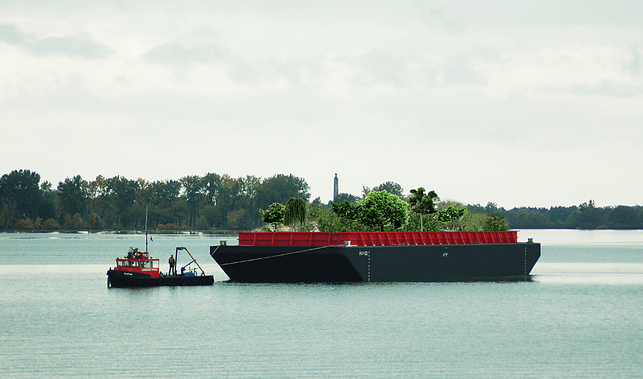Food Tank recently had the opportunity to interview Mary Mattingly who conceptualized Swale, a collaborative floating food project dedicated to rethinking and challenging New York City’s connection to its environment.
Food Tank (FT): What inspired your conceptualization of Swale?
Mary Mattingly (MM): In the art I make, I address water, food, shelter, and other necessities because these are the things I struggle with, living in an expensive city where meeting basic needs is often in jeopardy. Working towards a more holistic food system is important for many reasons, including the many injustices generated from industrial food systems. In New York City (N.Y.C.) picking plants in public spaces is illegal, it is considered the destruction of property. This law was created to protect public lands from being over-foraged, and has been enforced due to more recent turns in N.Y.C.’s park maintenance. As a public food forest, Swale can only exist in New York (N.Y.) because it is on the waterways. The waterways are the closest space we have in N.Y. to a true commons.
FT: How do you encourage people and communities to join the project? How many are currently involved?
MM: Swale addresses a need, and it’s very public. It can draw additional attention to the work that groups are already actively doing, and we reach out to align their work with ours to strengthen movements. Our group is mainly made up of about twenty-five people I have met with similar passions working towards similar, urgent goals of regeneration and local sustainability. Often these are people who work towards the equal distribution of wellness across this city and beyond. Everyone brings different skills and interests to the project and; therefore, it can take on a diverse set of directions.
FT: How do art, food, and water come together in this project?
MM: Swale is a floating food forest designed as an experiential artwork and site (and instigator) for long-term accessible public food, which is free and open to the public. Perennial food forestry reduces the cost as well as the time involved in annual gardening. Swale’s mission is broadly about co-educating through food, water, and experiential artwork. It increases understanding of the importance of fresh, healthy food, and access to clean water as a right for everyone. With Swale, we want to reinforce water as a commons, and work towards fresh food as a commons too.
FT: What drives you every day to fight for improving our food system?
MM: Frustration over our corporate, industrialized, toxic food system, and love for people as well as everything else affected by this system.
FT: Where do you see the project, and yourself, in five years?
MM: With our partner organizations, including; Youth Ministries for Peace and Justice; the Bronx River Alliance; Partnership for Parks; Rocking the Boat; and The Point, we would like Swale to find a permanent home in the Bronx. To do this, we are working towards a long-term maintenance plan with the N.Y.C. Department of Parks. Simultaneously we are working on public land in N.Y.C. where the edible perennial plants on Swale can be transplanted and accessible to anyone.
FT: Is there anything else that readers should know about Swale?
MM: With Swale, we are working towards more edible public spaces in the city, with the bigger goal of revaluing healthy food as not an expensive commodity but a basic human right. We see Swale as an opportunity for co-learning. We hope that this project continues a trajectory of work about alternatives to the dominant food system and reinforces how necessary it is for us all to be stewards of collective spaces.











